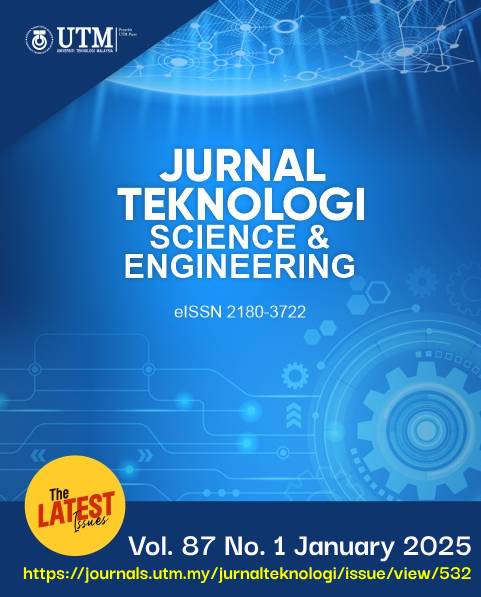CRUMPLE ZONE MODELLING OF PASSENGER VEHICLE USING MULTIPLE KELVIN MODEL AND OPTIMIZED WITH PARTICLE SWARM OPTIMIZATION
DOI:
https://doi.org/10.11113/jurnalteknologi.v87.22252Keywords:
Kelvin model, Multiple Kelvin model, Crumple Zone, Particle Swarm OptimizationAbstract
This paper presents the mathematical modelling of a vehicle crash system using a mass-spring-damper approach to simulate the behavior of a real vehicle during a frontal impact. A Multiple Kelvin model is developed to represent a real vehicle crash situation where the impact is introduced on the frontal vehicle body. The modelling process of Multiple Kelvin model is based on a single Kelvin model that developed into a set of seven mass-spring-damper systems representing the front crumple zone of a real vehicle. The model is then optimized for the parameters k and c using an optimization method namely Particle Swarm Optimization (PSO) algorithm in MATLAB-Simulink. The simulation results demonstrate deformation and acceleration responses closely follow the previous experimental results where the parameters namely Ni, Np, and iw are varied to enhance the model's precision through the calculation of error of 12.15 using parameters Ni = 80, Np = 40 and iw = 0.9.
References
Deac, S. C., Perescu, A., Simoiu, D., Nyaguly, E., Craştiu, I. & Bereteu L. 2018. Modeling and Simulation of Cars in Frontal Collision. IOP Conf. Ser. Mater. Sci. Eng. 294: 1.
Pawlus, W., Nielsen, J. E., Karimi, H. R. & Robbersmyr K. G. 2010. Development of Mathematical Models for Analysis of a Vehicle Crash. WSEAS Trans. Appl. Theor. Mech. 5(2): 156-165.
Marzbanrad, J. & Pahlavani, M. 2011. Calculation of Vehicle-lumped Model Parameters Considering Occupant Deceleration in Frontal Crash. Int. J. Crashworthiness. 16(4): 439-455.
Ofochebe, S. M., Ozoegwu, C. G. & Enibe, S. O. 2015. Performance Evaluation of Vehicle Front Structure in Crash Energy Management using Lumped Mass Spring System. Adv. Model. Simul. Eng. Sci. 2(1): 1-18.
Yang, X. & Liu, B. 2024. Frontal Crash Oriented Robust Optimization of the Electric Bus Body Frame Considering Tolerance Design. SAE Technical Paper. (No. 2024-01-2459).
Doan, C. V., Nguyen, C. T., V Vu, T., Nguyen, V. D. & Phan, P. T. 2021. Aerodynamic Characteristics Calculation and Shape Design Optimization of a Prototype Vehicle. AIP Conference Proceedings. 2420: 1.
Jaikumar, M., Koenig, P., Vignesh, S. K., Bentgens, F. & Hariram, V. 2022. Impact of Vehicle Collision using Modified Crash Box in the Crumple Zone-A Perspective Assessment. International Journal of Vehicle Structures & Systems. 14(4): 524-529.
Hussain, M. 2021. A Atudy of the Impact Attenuator. ACADEMICIA: An International Multidisciplinary Research Journal. 11(12): 208-213.
Marta, C. & Jorge, A. 2010. Identification of Multibody Vehicle Models for Crash Analysis using an Optimization Methodology. Multibody System Dynamics. 24: 325-345.
Carvalho, M., Ambrósio, J.& Eberhard, P. 2011. Identification of Validated Multibody Vehicle Models for Crash Analysis using a Hybrid Optimization Procedure. Struct. Multidiscip. Optim. 44: 85-97.
Perodua. 2023. Specification of Perodua Myvi. Retrieved on November 4, 2023, from htttps://www.perodua.com.my/our-models/myvi.html.
Pawlus, W., Karimi, H. R. & Robbersmyr, K. G. 2011. Development of Lumped-parameter Mathematical Models for a Vehicle Localized Impact. Journal of Mechanical Science and Technology. 25(7): 1737-1747.
Elkady, M., Elmarakbi, A., MacIntyre, J. & Alhariri, M. 2017. Collision Mitigation and Vehicle Transportation Safety using Integrated Vehicle Dynamics Control Systems. J. Traffic Transp. Eng. 4(1): 41-60.
Zubir, A. R., Hudha, K., Kadir, Z. A & Amer, N. H. 2023. Enhanced Modeling of Crumple Zone in Vehicle Crash Simulation using Modified Kamal Model Optimized with Gravitational Search Algorithm. Automotive Experiences. 6(2): 372–3.
Zhang, Y.& Wu, L. 2011. A Hybrid TS-PSO Optimization Algorithm. J. Converg. Inf. Technol. 6(5): 169-174.
Engelbrecht, A. P. 2013. Particle Swarm Optimization: Global Best or Local Best? Proc. 1st BRICS Ctries. Congr. Comput. Intell. BRICS-CCI. 1: 124-135.
Ebbesen, S., Kiwitz, P. & Guzzella, L. 2012. A Generic Particle Swarm Optimization Matlab Function. Proc. Am. Control Conf. 1519-1524.
Nabab, M. 2016. Codes in MATLAB for Particle Swarm Optimization. 1: 8-12.
Mnyazikwiye, B. Karimi, H. R.& Robbersmyr, K. G. 2013. Mathematical Modeling of Vehicle Frontal Crash by a Double Spring-mass-damper Model. 24th Int. Conf. Information, Commun. Autom. Technol. 2013: 1-6.
Moutari, S. & Herty, M. 2014. A Lagrangian Approach for Modeling Road Collisions using Second-order Models of Traffic Flow. Commun. Math. Sci. 12(7): 1239-1256.
Yan, J. & Osadciw, L. A. 2008. Varying dimensional Particle Swarm Optimization. IEEE Swarm Intell. Symp. SIS.
Jain, M., Saihjpal, V., Singh, N., Singh, S. B. 2022. An Overview of Variants and Advancements of PSO Algorithm. Applied Sciences. 12(17): 8392.
Li, X.-L., Serra, R. & Olivier, J. 2019. Effects of Particle Swarm Optimization Algorithm Parameters for Structural Dynamic Monitoring of Cantilever Beam. Surveillance, Vishno AVE Conf. 1–7.
Clerc, M. 2010. Particle Swarm Optimization. Part. Swarm Optimization.
Huang, M., Zhao, Z. & Liang, X. 2019. Application of Improved Particle Swarm Optimization in Vehicle Depot Overhaul Shop Scheduling. Proc. IEEE 7th Int. Conf. Comput. Sci. Netw. Technol. 103-106.
Chauhan, P., Deep, K. & Pant, M. 2013. Novel Inertia Weight Strategies for Particle Swarm Optimization. Memetic Comput. 5(3): 229-251.
Elkady, M. & Elmarakbi, A. 2012. Modelling and Analysis of Vehicle Crash System Integrated with Different VDCS under High Speed Impacts. Open Engineering. 2(4): 585-602.
Elkady, M., Sheikh, M. & Burn, K. 2018. Numerical Analysis for Vehicle Collision Mitigation and Safety using Dynamics Control Systems. Advances in System Dynamics and Control. 421-475. IGI Global.
Hogan, I. & Manning, W. 2008. The Development of a Vehicle Collision Mitigation Control System through Multi-Body Modelling. FISITA.
Downloads
Published
Issue
Section
License
Copyright of articles that appear in Jurnal Teknologi belongs exclusively to Penerbit Universiti Teknologi Malaysia (Penerbit UTM Press). This copyright covers the rights to reproduce the article, including reprints, electronic reproductions, or any other reproductions of similar nature.
















